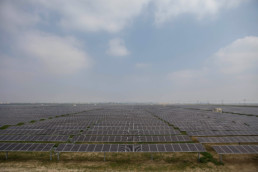In the heart of Texas, Georgetown’s utility is providing 100% renewable electricity to 60,000 citizens, proof that the economic and health benefits of renewables are difficult to oppose.
Georgetown Utility Systems (GUS) serves 60,000 people and has developed a new power plan focused on long-term, fixed-priced generation of renewable energy. The utility has entered into contracts with large wind (144 MW) and solar (150 MW) generators, using Renewable Energy Certificates (RECs) to guarantee renewable origins of electricity. As of April 2017, the utility provides 100% renewable electricity to the people of Georgetown.

With another large solar plant expected to come online in 2018, the utility will have more than enough power to guarantee renewable electricity supply, and is developing more decentralized solar options as well as storage solutions to meet future peak demand. By transitioning to 100% renewable electricity, GUS is providing customers with a stable, long-term electricity price that mitigates any price volatility associated with fossil fuels and potential future carbon legislation.
384K of CO2 per year saved by transitioning to 100% renewables
The challenge
The population of Texas is expected to double in the next 50 years, putting pressure on already limited resources, including water. Wind and solar energy require essentially no water to operate and do not pollute water resources or stress supply by competing with agriculture or drinking water.
Co-benefits
Economic Customers can expect an almost-static electricity rate between $0.09 and $0.095 per kWh now and into the future. Comparatively, the coal and gas markets are notoriously unpredictable.
Environmental Transitioning to renewables can alleviate environmental concerns from fracking, used to extract natural gas from previously inaccessible fossil fuel reserves. These concerns include water pollution and unintended tectonic activity.
Health The flat landscapes seen across Texas are conducive to consistent winds, making it ideal for wind farm development, and particularly bad for coal plants, which produce particulate pollution damaging to health.
About Georgetown
Georgetown is a city in Williamson County, Texas, United States, with a population of 47,400 at the 2010 census and a population of 63,716 at the 2016 Census estimate. Georgetown has a notable range of Victorian commercial and residential architecture. In 1976, a local historic ordinance was passed to recognize and protect the significance of the historic central business district, and in 1977, the Williamson County Courthouse Historical District, containing some 46 contributing structures, was listed on the National Register of Historic Places. Georgetown is also known as the “Red Poppy” Capital of Texas for the red poppy (Papaver rhoeas) wildflowers planted throughout the city. Georgetown’s Red Poppy Festival, which attracts up to 30,000 visitors annually, is held in April each year on the historic square.


